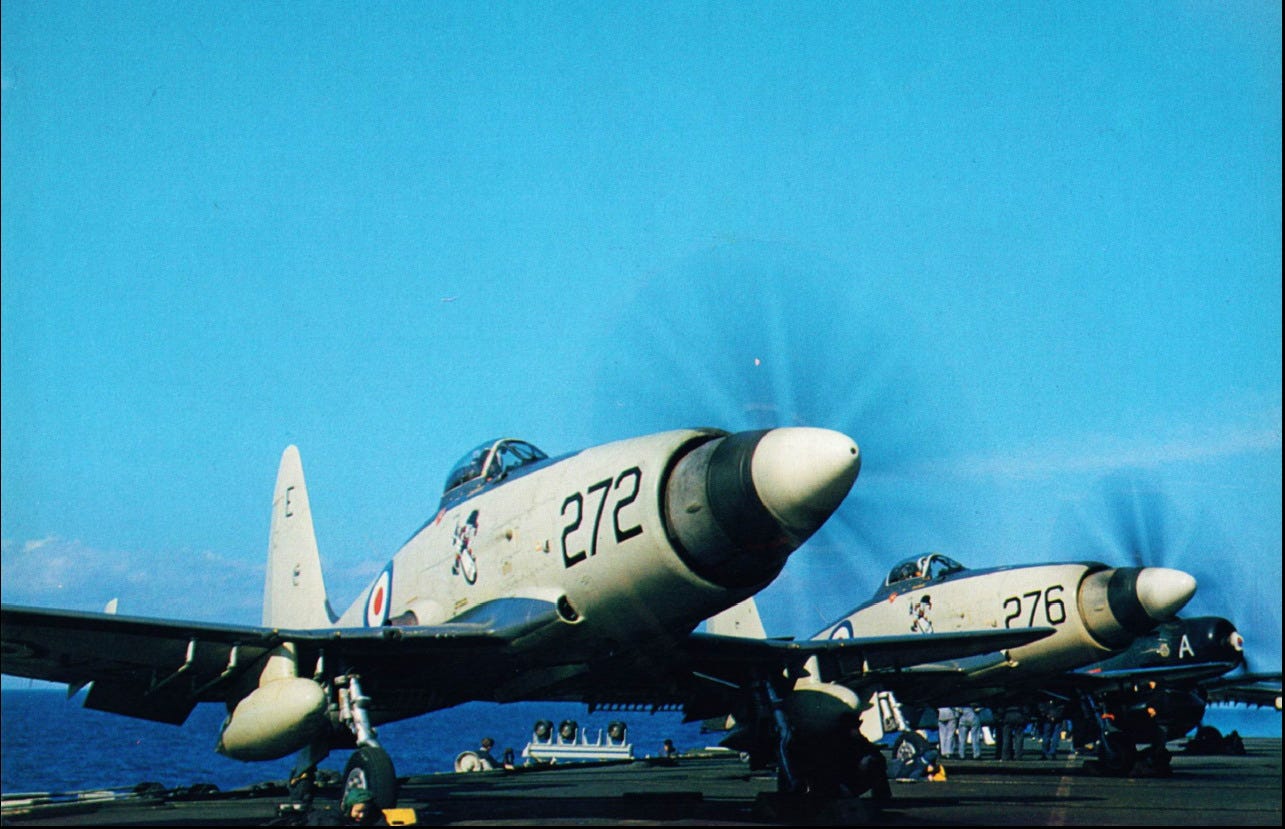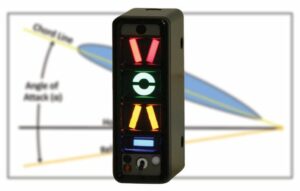Prepare for contra-rotating madness on the deck!

The weight of a Dakota, the rampant good looks (and handling) of a rhino on heat, with more horsepower than Genghis Khan, the Westland Wyvern was a thug. This Fleet Air Arm monster was a strike aircraft for a dying empire wishing to administer a little more pain before it bowed out.
Teddy Petter was a complicated man. He gave the world the Whirlwind fighter, the Canberra, and the Gnat* In January 1960, Petter left the aircraft industry forever to become a holy man. He joined the religious commune of ‘Father Forget’ in Switzerland. Years before this, he had started work on one of the most unholy machines in history, the truly wild Westland Wyvern.

*The intakes were designed by Michal Giedroyc, father of British TV presenter Mel Giedroyc from Mel & Sue fame
8. Where should the engines go?
Though the Wyvern looked sensational, it was obsolescent when it finally entered service in 1953. It had first flown in 1946. Its decade-long development essentially condemned it to relative obscurity. This was not the fault of the intrinsic design, which was basically sound, but because the aircraft had to be redesigned not once, but twice, to accept a different engine when the preferred choice became unavailable. Frankly, it’s remarkable that the Wyvern made it into service at all.

When Teddy Petter designed the aircraft in the mid-forties, the intention was to fit a turboprop engine when one became available. The fact that a turboprop engine had not even been flown at this stage shows just how forward-thinking this was. In the meantime, the Air Ministry suggested using the new Rolls-Royce Eagle piston engine, which would be run for the first time in March 1944. However, before this occurred, the Wyvern, as it existed on paper, was a very different creature. Part of the naval requirement was that the new aircraft should boast an excellent view for landing on a carrier deck. However, with conventional single-engined aircraft at the time, this view was impaired by an enormous aero engine placed directly in front of the pilot. Petter initially decided the best way around this was to remove the view-obscuring engine and put it elsewhere.

His first proposal, influenced by discussions with Commodore (later Rear Admiral and chairman of BOAC) Matthew Slattery, Head of the Naval Aircraft and Production Department, featured two Merlin engines mounted in tandem with a drive shaft to rear-mounted contra-rotating propellers. This configuration was (unsurprisingly perhaps) deemed too complex and too much of a risk in the event of a ‘waved-off’ carrier landing, quite apart from risking a diced pilot in the event of bailing out.

Undeterred, Petter decided the Wyvern should instead place a single Eagle (engine, not bird) behind the pilot and drive the propeller by a shaft a la Bell P-39 Airacobra, allowing a good view over the nose for carrier operations and a configuration Westland already had experience with after building the experimental F.7/30 fighter of 1934, designed by Arthur Davenport, then chief designer at Westland. However, others felt that this configuration was too complex and took matters into their own hands. While Petter was away in London, Harald Penrose, Westland’s chief test pilot (who, as well as being an amateur aircraft and yacht designer, would survive four forced landings whilst flight testing the Wyvern), set about modifying the Wyvern mock-up: he cut a cockpit hole in the fuselage above the wing and raised the top line of the fuselage with curved battens until the same view over the nose could be obtained with the engine in the nose as with the rear-mounted engine. Arthur Davenport, still at Westland but now Petter’s deputy, liked the simplicity of this solution. The design was subsequently approved at a mock-up conference with officials, and the rear-mounted engine was discarded.


Now located in the nose, the engine was a complete departure from previous Rolls-Royce products. The sleeve valve Eagle featured a 24-cylinder H-form layout with two horizontally opposed flat 12-cylinder engines driving two crankshafts geared together to power the airscrew. This was precisely the same layout as the wartime Napier Sabre, but imitation is the sincerest form of flattery, and it seems that Rolls-Royce had realised that Napier were building a better-designed engine than their own Merlin and Griffon. The Eagle delivered a whopping 3500 hp and bid fair to endow the Wyvern with a decent enough performance (notwithstanding the Wyvern’s incredible heft), but sadly for Westland, Rolls-Royce decided the future lay with jets (correctly as it turned out) and the Eagle was abandoned.
“I thought the Wyvern was a beautifully built aircraft, but engine and airframe were both new and this is usually a drawback. Taking over 813 Squadron in December 1954, and wishing to arrive in style, I got a Wyvern from Lee-on-Solent to fly out to Malta to join the ship. This particular one had the very latest cartridge starter, two immense cartridges inserted just behind the main air intake. By the time I was ready to start I was expecting something really exciting. It was a few days before November 5.
When I pressed the starter button, the cartridge gases ignited in the engine compressor and blew the spinner backplate into the front propeller, the whole thing flew to pieces and the odds and sods went into the engine and wrecked it. I got to Malta a week later, by Dakota.” – Commander Mike Crosley DSC,
Fly Navy (Pen & Sword Books)
Hush-Kit Aviation Newsletter is a reader-supported publication. To receive new posts and support my work, consider becoming a free or paid subscriber.
The Wyvern was duly reworked to accept a very promising turboprop engine, the Rolls-Royce Clyde. This engine was lighter than the Eagle but was rated at an impressive 4030 hp, exactly the sort of power the Wyvern needed. Sadly for Westland (again), Rolls-Royce felt the future lay with pure turbojets, not turboprops (incorrectly this time). Hedging their bets somewhat, development of the (ultimately very successful) Dart continued, but the Clyde was abandoned. This left very few options for the Wyvern and Westland alighted on the best of what was left, the Armstrong Siddeley Python. This was not an ideal engine for a carrier fighter and was more challenging to integrate with the airframe. Subsequent testing revealed that the Python did not like the sudden acceleration of a catapult-assisted takeoff and had a tendency to flame out immediately after launch. This very problem led to the most famous Wyvern escape, described further down. It also suffered from a prolonged spool-up time, meaning that speed changes, such as might be needed in a go-around, were far less rapid than desired. These issues were improved over time, but never entirely eradicated and most of the operational accidents of the Wyvern could be ascribed to the unfortunate Python.

As for visibility, Georges Barras of 813 Squadron noted, “..the long nose totally obscured the landing area of the deck, leaving the pilot to find the centre line by keeping in the middle between the mirror landing sight on the left and the island and the island superstructure on the right. It was a bit hit and miss as to which wire, if any, were caught, and there was a high proportion of ‘bolters’ (missed all the wires, go round again.”


7. Wyvern Tail

The Wyvern is named for a type of dragon with two legs, two wings, which often has a pointed tail. Presumably as a nod to this mythical beast, Petter gave the aircraft a massive….read the rest of the exciting Wyvern story on our Substack here.




